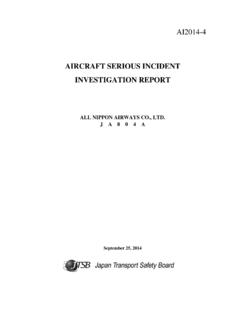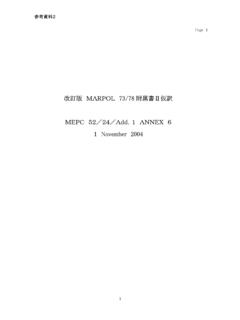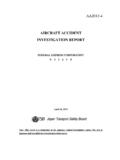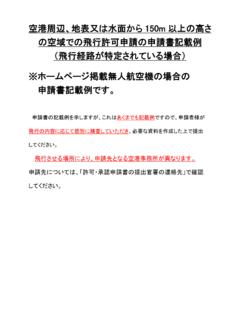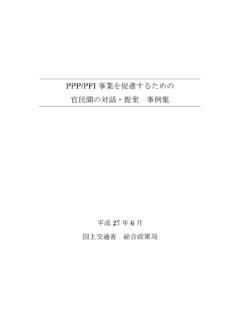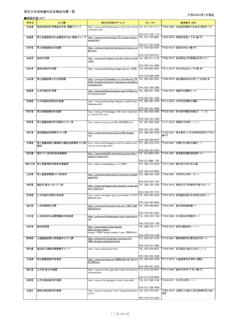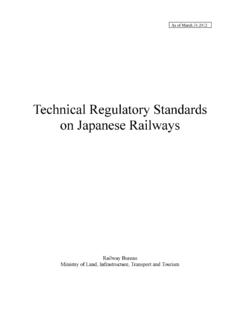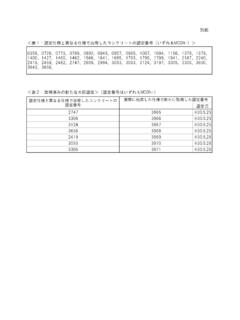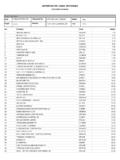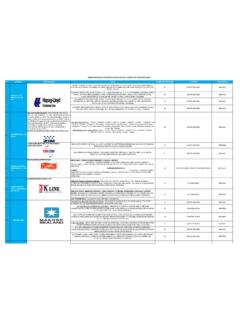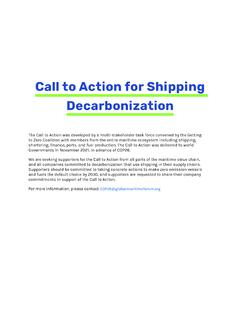Transcription of Roadmap to Zero Emission from International Shipping
1 Provisional translation* (As of May 27, 2020). Ministry of Land, Infrastructure, Transport and Tourism Roadmap to zero Emission from International Shipping March 2020. Shipping zero Emission Project *This document was originally written in Japanese. This English version is provided for reference purposes only. Foreword Amid globally growing momentum for decarbonization since the Paris Agreement came into effect in 2016, further reduction of greenhouse gas (GHG) emissions has become an urgent issue in International Shipping , which currently accounts for approximately 2% of global GHG emissions and is expected to significantly grow in the future. In April 2018, the International Maritime Organization (IMO) adopted the Initial Strategy on reduction of GHG emissions from ships , aimed at reducing the GHG emissions from International Shipping by at least 50% by 2050 and phasing them out as soon as possible in this century.
2 Currently, in accordance with the Strategy, discussion and consideration on short-term measures are underway at the IMO with a view toward reaching an agreement by 2023. Japan is one of the major players in global Shipping and shipbuilding sectors. In order to actively contribute to International actions to address the climate change while ensuring the sustainable growth of maritime transport and related industries, Japan established the Shipping zero Emission Project , in collaboration with the industrial, academic, and public sectors, in August 2018. The Japan Ship Technology Research Association (JSTRA) and the Ministry of Land, Infrastructure, Transport and Tourism (MLIT) are taking the lead in organizing this project with the support from the nippon Foundation. <Institutions and organizations participating in the Shipping zero emissions Project>. (Organizer) (Co-Organizer). (Supporter). Shipping zero Emission Project <Steering Group Members>.
3 Hiroaki Project Manager, International Shipping GHG zero emissions Project Sakashita President & CEO, nippon Kaiji Kyokai (ClassNK). Ken Takagi Professor, Department of Ocean Technology, Policy, and Environment, Graduate School of Frontier Sciences, The University of Tokyo Akira Okada Associate Professor, Environmental Management and Sustainability, Faculty of Environmental Studies, Tokyo City University Tatsumi Associate Professor, Department of Mechanical Engineering, Graduate School of Kitahara Engineering, Kyushu University Seijiro Senior Researcher, Planning and Research Department, Japan Maritime Center Morimoto Katsuji Managing Director for Research Affairs, National Maritime Research Institute, Tanizawa National Institute of Maritime, Port and Aviation Technology Toshiyuki Corporate Officer, Director of Research Institute, nippon Kaiji Kyokai (ClassNK). Matsumoto Hideyuki Senior Director, Joint Construction of Ship Assistance Department, Japan Railway Asaoka Construction, Transport and Technology Agency (JRTT).
4 Kumiko Iwasa General Manager, Environment Management Group, Kawasaki Kisen kaisha , Ltd. ( K Line). Hirohiko Oyabu Assistant to Director Technical Division Technology Innovation unit, Mitsui Lines, Ltd. Masahiro General Manager, Environment Group, nippon yusen kaisha (NYK Line). Takahashi Norihiro Senior Staff Officer, Engineering Division, Ship & Offshore Structure Company, Wakiyama Kawasaki Heavy Industries, Ltd. Tsuyoshi Technical Executive, Design Division, Japan Marine United Corporation Ishiguro Takashi Unseki Chief Engineer, Energy & Environment, Marine Engineering Center, Mitsubishi Shipbuilding Co., Ltd. Tomohiro Managing Director & General Manager, Design Division, Asakawa Shipbuilding Asaumi Co., Ltd. Hideaki General Manager, Research & Development Department, Engineering &. Nagasawa Technology Center, IHI Power Systems Co., Ltd. Kazutaka Deputy General Manager, Diesel Design Department, Diesel Engine Division, Shimada Mitsui E&S Machinery Co.
5 , Ltd. <Managers of Associate Projects>. Akihiko Azetsu Project Manager, Project for Energy Efficiency Technical Standards, Japan Ship Technology Research Association Professor, Department of Mechanical Engineering, School of Engineering, Tokai University Koji Takasaki Project Manager, Project for Air Pollution Prevention Standards, Japan Ship Technology Research Association Professor Emeritus, Kyushu University Organizer: Japan Ship Technology Research Association (JSTRA) and Ministry of Land, Infrastructure, Transport and Tourism (MLIT). Support: The nippon Foundation This project has established three Task Forces under the Steering Group: the Task Force on ship design, the Task Force on ship operation, and the Task Force on alternative fuels. This project has been carried out with the participation of more than 50 experts from related industries and organizations. Table of Contents Chapter 1 Introduction 1.
6 Section Background 1. Section Purpose 1. Section Outline of the Project 2. Chapter 2 The Initial IMO Strategy on Reduction of GHG emissions from Ships and 3. Perspectives on Achieving its Targets Section Targets Set by the Strategy 3. Section Toward Achieving the 2030 Target 4. Section Toward Achieving the Target for 2050 4. Section Toward Achieving zero emissions in This Century 5. Chapter 3 Measures for Achieving the 2030 Target 6. Section Improving the Energy Efficiency of New Ships (EEDI Regulations) 6. Section Improving the Energy Efficiency of Existing Ships 6. Necessity of Measures on Existing Ships 6. Development of New Energy Efficiency Regulations on Existing Ships 7. Estimation of the GHG Reduction Effects by means of EEXI Regulations 8. Section Towards further Operational Improvements 8. Chapter 4 Emission Pathways for Achieving the 2050 Target 9. Section Outline of the Development of Emission Pathways 9.
7 Section Estimate of International Seaborne Trade and Required Reduction of GHG 9. emissions Estimate of International Seaborne Trade 9. Estimate of GHG emissions in Business-As-Usual (BAU) Scenario: 12. Continued Use of Conventional Technologies and Fuels Reduction in GHG emissions and Carbon Intensity Required to Achieve the 13. 2050 Target Section Reduction in GHG emissions and Carbon Intensity Required to Achieve the 14. 2050 Target Feasibility Study on Potential Fuels and Technological Options 14. Emission Pathways for Achieving the 2050 Target and beyond 19. Section Concept Designs for Ultra-low or zero Emission Ships 25. Hydrogen-Fueled Ships 25. Ammonia-Fueled Ships 28. Onboard CO2 Capturing Ship 29. Super-efficient LNG-Fueled Ships 30. Conceptual Drawings of zero Emission Ships 32. Chapter 5 Roadmap to zero Emission from International Shipping 33. Section Outline of the Roadmap 33. Section Research and Development 34.
8 Enhancing Research and Development capacities 34. Pilot Projects 34. Section Regulatory Developments 35. Short-, Mid- and Long-Term Measures 35. Revision to Existing MARPOL-Related Regulations 36. Safety requirement 36. Others 36. Chapter 6 Concluding remarks 38. Appendix 1 Estimate of International Seaborne Trade 41. Appendix 2 Feasibility of Alternative Fuels and GHG Reduction Technologies 59. Appendix 3 Ultra-low or zero Emission Ships 73. Appendix Hydrogen-Fueled Ships 73. 3-1. Appendix Ammonia-fueled Ships 86. 3-2. Appendix Onboard CO2 Capturing Ship 96. 3-3. Appendix Super-efficient LNG-fueled Ships 107. 3-4. Appendix 4 Life cycle accounting of GHG emissions 127. Chapter 1: Introduction Section : Background According to the study on greenhouse gas (GHG) emissions from International Shipping conducted by the International Maritime Organization (IMO) in 2014, total CO2 emissions from International Shipping as of 2012 was approximately 800 million tons, around of global CO2 emissions .
9 Demand for maritime transport is forecasted to increase amid the growth of the world economy. Measures for tackling the climate change in a global manner are being discussed under the United Nations Framework Convention on Climate Change (UNFCCC). However, GHG emissions from International Shipping and aviation sectors operating beyond national borders are difficult to be separated and allocated to countries, by nationality of the ship or aircraft, or by the country that operates them. Thus, actions to reduce emissions from these sectors are not compatible with the country-specific reduction measures of the UNFCCC. For these reasons, discussions on measures on these sectors have been delegated to United Nations specialized agencies, the IMO and the International Civil Aviation Organization (ICAO), respectively. The IMO adopted the initial IMO Strategy on Reduction of GHG emissions from Ships (hereafter the IMO Strategy ) to reduce GHG emissions from ships in April 2018.
10 The IMO Strategy sets quantified GHG reduction targets: (1) to reduce carbon intensity ( CO2 emissions per transport work) of International Shipping by at least 40% by 2030 compared to 2008, (2) to reduce the total annual GHG. emissions from International Shipping by at least 50% by 2050 compared to 2008, and (3) to phase out GHG emissions from International Shipping as soon as possible, in this century. The International Shipping sector had already been making efforts to reduce the GHG emissions from ships prior to the adoption of the IMO Strategy. For example, it had introduced the mandatory energy efficiency design index (EEDI) for new ships. However, to achieve the targets under the IMO Strategy, especially the targets for 2050 and beyond, it is necessary to not only continue these ongoing efforts but also to introduce and speed up actions that goes beyond the conventional ones, such as transition from fossil and other conventional fuels to low- and zero -carbon fuels and introduction of innovative technologies.
